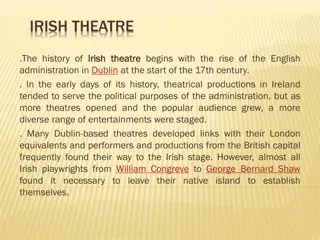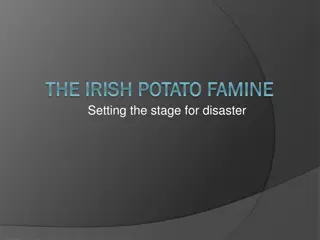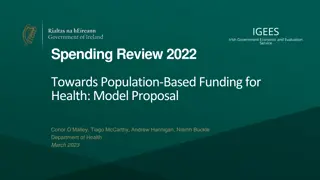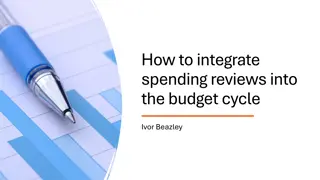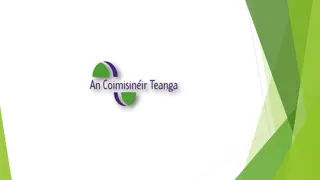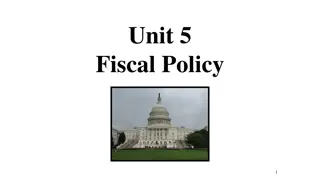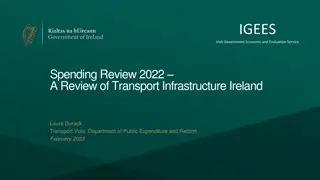IGEES Irish Government Economic and Evaluation Service Spending Review 2022: Capital Investment Programmes
The Spending Review 2022 by IGEES explores the planning, appraisal, and management of capital investment programmes in Ireland. It highlights the need for updated guidance to address shortcomings and improve the effectiveness of public spending on capital investments.
Download Presentation

Please find below an Image/Link to download the presentation.
The content on the website is provided AS IS for your information and personal use only. It may not be sold, licensed, or shared on other websites without obtaining consent from the author.If you encounter any issues during the download, it is possible that the publisher has removed the file from their server.
You are allowed to download the files provided on this website for personal or commercial use, subject to the condition that they are used lawfully. All files are the property of their respective owners.
The content on the website is provided AS IS for your information and personal use only. It may not be sold, licensed, or shared on other websites without obtaining consent from the author.
E N D
Presentation Transcript
PROJECT PHASES Identification Preparation Appraisal Approval Implementation Completion Evaluation Termination
CONCEPTUALIZATION PHASE The initiation processes determine the nature and scope of the project. The key project controls needed here are an understanding of the social environment and making sure that all necessary controls are incorporated into the project
PLANNING The initiation stage should include a plan that encompasses the following areas: Analyzing the needs/requirements in measurable goals Reviewing of the current operations Financial analysis of the costs and benefits including a budget Stakeholder analysis, including users, and support personnel for the project Project charter including costs, tasks, deliverables, and schedule
FORMATION PHASE (PREPARING PROPOSAL) Preparing the proposal After the initiation stage, the project is planned to an appropriate level of detail. The main purpose is to plan time, cost and resources adequately to estimate the work needed and to effectively manage risk during project execution. As with the Initiation process, a failure to adequately plan greatly reduces the project's chances of successfully accomplishing its goals.
PROJECT PLANNING GENERALLY CONSISTS OF Determining how to plan; Developing the scope statement; Selecting the planning team; Identifying deliverables and creating the work breakdown structure; Identifying the activities needed to complete those deliverables and networking the activities in their logical sequence;
Estimating the resource requirements for the activities; Estimating time and cost for activities; Developing the schedule; Developing the budget; Risk planning; Gaining formal approval to begin work.
OPERATIONAL PHASE (EXECUTING) Executing consists of the processes used to complete the work defined in the project management plan Execution process involves coordinating people and resources Integrating and performing the activities of the project in accordance with the project management plan. The deliverables are produced as outputs from the processes performed as defined in the project management plan
PLANNING IN OPERATIONAL PHASE Monitoring processes performed to observe project execution so that potential problems can be identified in a timely manner and corrective action can be taken, when necessary, to control the execution of the project. and controlling consists of those The key benefit is that project performance is observed and measured variances from the project management plan regularly to identify
MONITORING AND CONTROLLING It consists of those processes performed to observe project execution The key benefit is that project performance is observed and measured regularly to identify variances from the project management plan Measuring the ongoing project activities ('where we are'); Monitoring the project variables (cost, effort, scope, etc.) against the project management plan and the project performance baseline (where we should be); Identify corrective actions to address issues and risks properly (How can we get on track again);
TERMINATION/ WITHDRAWAL PHASE Closing includes the formal acceptance of the project and the ending thereof. Administrative activities include the archiving of the files and documenting lessons learned. This phase consists of: Project close: Finalize all activities across all of the process groups to formally close the project or a project phase Contract closure: Complete and settle each contract and close each contract applicable to the project or project phase
PLANNING: TERMINATION PHASE Finalize all activities across all of the process groups to formally close the project or a project phase Complete and settle each contract and close each contract applicable to the project or project phase Question of sustainability







